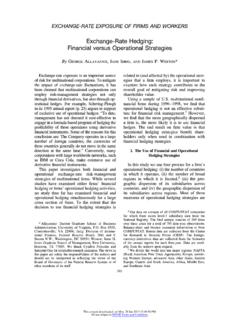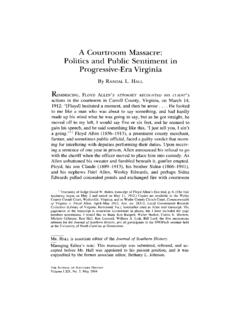Transcription of WRITING A RESEARCH PAPER FOR A GRADUATE SEMINAR …
1 WRITING A RESEARCH PAPER FOR A GRADUATE . SEMINAR IN political SCIENCE. Ashley Leeds Rice University Here are some basic tips to help you in WRITING your RESEARCH PAPER . The guide is divided into six sections covering distinct aspects of your PAPER . You need not organize your PAPER using these same sections, but you will need to accomplish all of these goals. Two publications I found useful in putting together this guide are: Becker, Howard S. 1986. WRITING for Social Scientists: How to Start and Finish your Thesis, Book, or Article. Chicago: The University of Chicago Press. King, Gary, Robert O. Keohane, and Sidney Verba.
2 1994. Designing Social Inquiry. Princeton: Princeton University Press. The Introduction: The introduction is an important part of your RESEARCH PAPER . While your introduction should be relatively concise, accomplishing the goals below will take more than one paragraph. In your introduction, you should accomplish the following: 1. Capture the interest of the reader. Perhaps you can do this by pointing out a puzzle that we don't yet understand or a controversy in current scholarship. Perhaps you can draw on the normative importance of your topic to draw the reader in. Make someone want to know what you have to say. 2. State your RESEARCH question clearly and explain why we should care about the answer.
3 3. Preview your argument and conclusions and provide a roadmap through the PAPER let the reader know where you are going and what to expect. Reference to specific sections may be helpful here. 4. Explain the value-added in your study. How does your work advance knowledge? For instance, are you developing a new argument? Are you extending an existing argument? Are you evaluating an argument in a new empirical domain? Where does your work fit in the established literature and what is new about it? The Literature Review: Next you must situate your RESEARCH project within the literature and show how your project moves existing scholarship forward.
4 In order to do this, you must demonstrate your understanding of the current state of theory and evidence on your topic and the ways in which your proposed project improves upon existing work. In other words, you must review the relevant literature. The most common mistake that students make in WRITING a literature review for a RESEARCH PAPER is to lose sight of its purpose. You include the literature review to explain both the basis for and contribution of your RESEARCH project. The literature review should be focused on issues directly relevant to your study and should be organized in a way to call attention to the contributions of your RESEARCH .
5 The purpose of the literature review is NOT to show that you have read a lot of material. Summarizing as many books and articles as you can, whether or not they relate directly to your RESEARCH question, is not a good strategy. Short, well focused literature reviews are more effective than long, meandering ones. At the same time, you must demonstrate your understanding for the current state of the field. A sure way to try a reader's patience and to get off track in developing your argument is to produce a literature review that offers a list of summaries of individual books and articles without making clear how they fit together and why they represent a coherent body of work that serves as a starting point for your project.
6 Literature reviews that start with A number of scholars have studied the relationship between X. and Y and proceed to list who has studied the topic and what each scholar concluded may show your professor that you have read a lot of articles, but this type of literature review is unlikely to be an asset to your PAPER . A literature review should not be merely a technical reporting of what has been done before, but a creative organization of past work that helps to frame and build your argument. Good literature reviews order individual articles and books into groups, producing typologies that help readers to see unresolved debates, inconsistencies, and new questions clearly and quickly.
7 By organizing past RESEARCH in this way, you can convince the reader that your RESEARCH , which will help to resolve these debates and/or inconsistencies or answer these new questions, is particularly important. Howard S. Becker, in his book, WRITING for Social Scientists (U of Chicago Press, 1986) describes a literature review as follows: Imagine you are doing a woodworking project, perhaps making a table. You have designed it and cut out some of the parts. Fortunately, you needn't make all of the parts yourself. Some are standard sizes and shapes .. Some have already been designed and made by other people .. All you have to do is fit them into the places you left for them, knowing that they were available.
8 That is the best way to use the literature. You want to make an argument, instead of a table. You have created some of the argument yourself .. But you needn't invent the whole thing. Other people have worked on your problem or problems related to it and have made some of the pieces you need. You just have to fit them in where they belong (141-142). There are many possible ways of designing a literature review that can be effective. There is not one correct way to organize and report on the current state of the field. At the same time, it is very important to choose an organization scheme and to move purposefully from one point to another, guiding the reader to a conclusion.
9 Your literature review should be designed to lead the reader to the conclusion that your RESEARCH is an important next step in our understanding of the phenomenon in question. One way of designing a literature review is as a debate among two or more competing theories of the same phenomenon. If your RESEARCH can discriminate between the theories and allow for the conclusion that one may be more appropriate than the other, or if your RESEARCH can integrate the theories and suggest that they are not competitors at all, this can be an effective way of framing your study. Another way is to set up your PAPER as a challenge to existing theory.
10 Here, you use an existing body of literature as a foil and explain why your approach to the problem is superior. A third way is to demonstrate how existing literature has led to progressive refinement of our understanding of a phenomenon; this is particularly effective if your RESEARCH serves as the next step in this refinement process. All of these approaches share the goal of demonstrating how your work will lead, however incrementally, to the continued cumulation of knowledge. A good literature review will convince the reader that your project fits into an established body of work and addresses a question of concern to the scholarly community, and also that your project adds to our understanding of the topic by offering something new.




